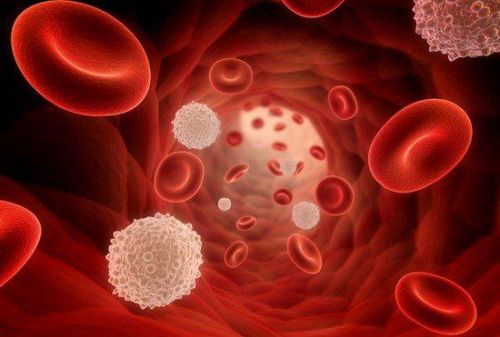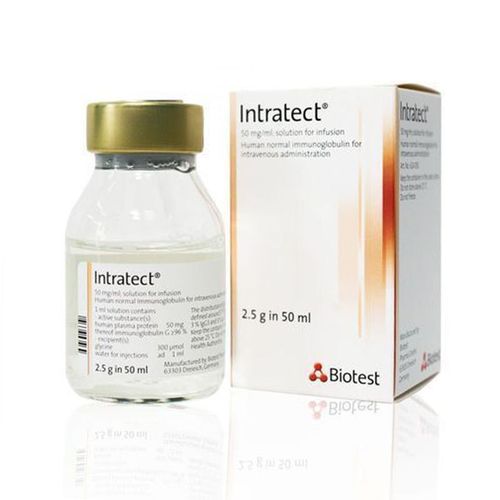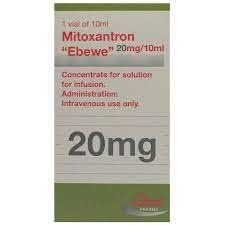This is an automatically translated article.
Omacetaxine Mepesuccinate is also known as Synribo. This is a prescription medication used to treat chronic myeloid leukemia or leukemia in adults. Synribo belongs to a group of drugs that inhibit protein synthesis, slowing the growth of cancer cells.
1. What is Omacetaxine Mepesuccinate?
Omacetaxine Mepesuccinate is a drug that belongs to the group of inhibitors of protein synthesis. The mechanism of action of the active ingredient is still unclear. Omacetaxine Mepesuccinate is a protein inhibitor that reduces the level of Bcr-Abl (the Philadelphia chromosome) in the body.
2. How to use Omacetaxine Mepesuccinate?
Omacetaxine Mepesuccinate is used by injection under the skin, similar to how insulin is injected. The dose of injection will be prescribed by the doctor. You or your caregiver should wear gloves and protective glasses while giving the medicine. If you get Omacetaxine Mepesuccinate on your skin, wash it off with soap and water. If you get Omacetaxine Mepesuccinate in your eyes, flush your eyes with water and call your doctor right away. Do not eat or drink while handling Omacetaxine Mepesuccinate and always wash your hands before and after giving you the medication. Women who are pregnant or breastfeeding should not prepare therapeutic doses for you. If you miss a dose, skip that dose and inject your next dose at the scheduled time. Never take 2 doses in a row to make up for a missed dose.
3. How to store Omacetaxine Mepesuccinate?
Omacetaxine Mepesuccinate will be premixed by healthcare professionals in a single dose syringe. Transport the medication according to your provider's instructions. You can store the vial in the refrigerator for up to 6 days or at room temperature for up to 12 hours. When storing Omacetaxine Mepesuccinate in the refrigerator, keep it away from food and drink. Keep the vials out of reach of children and household pets. Do not reuse or recap the syringe or needle. Do not dispose of vials, syringes, or needles in the household trash. All used needles and syringes should be disposed of in a puncture-proof disposable container with a lid. In the event that Omacetaxine Mepesuccinate is spilled, use the supplies provided to clean up the spill. Do not touch spills unless you are wearing gloves and protective glasses. Use an absorbent pad to clean up spills. Wash the area with soap and water and pat dry with a paper towel. Dispose of all materials in the biohazard container and report the spill to an environmental disposal unit.
4. Undesirable effects of the drug Omacetaxine Mepesuccinate
Common unwanted effects that may occur when using Omacetaxine Mepesuccinate:
4.1. Low platelet count, decreased platelet count Platelets are factors that have an effect on blood clotting. So when your platelet count is low, you have a higher risk of bleeding. You need to watch for signs of low platelets such as any bruising or excessive bleeding, including nosebleeds, bleeding gums, or blood in your urine or stools. If your platelet count becomes too low, your doctor may prescribe extra platelet transfusions.
At the same time, you should also apply some methods to reduce the risk of bleeding as follows:
Do not use a razor. Avoid participating in sports and contact activities that could cause injury or bleeding. Do not use aspirin (salicylic acid), nonsteroidal anti-inflammatory drugs such as Motrin/Advil (ibuprofen), Aleve (naproxen), Celebrex (celecoxib). This is because these drugs can all increase the risk of bleeding. You should tell your treating doctor about all over-the-counter medications or supplements while you're on treatment. Do not floss or use toothpicks and use a soft-bristled toothbrush to brush your teeth. 4.2. Infections and low white blood cell counts Omacetaxine Mepesuccinate can cause life-threatening infections, with or without lowering the white blood cell count. White blood cells (WBCs) are important for fighting infection. While being treated, your white blood cell count may drop, putting you at higher risk of infection. You should tell your doctor right away if you have a fever with a temperature higher than 100.4°F equivalent to 38°C accompanied by a feeling of severe sore throat or cold, shortness of breath, cough, burning sensation when urinating or long-term pain that does not go away.
4.3. Low red blood cell count or anemia Your red blood cells are responsible for carrying oxygen to the tissues in your body. When your red blood cell count is low, you may feel tired or weak. You should notify your treating doctor if you experience shortness of breath, shortness of breath or chest pain. If your red blood cell count is too low, your doctor may recommend a blood transfusion.
4.4. Diarrhea The treating doctor can prescribe medicines to reduce diarrhea. Also, try eating bland, low-fiber foods, such as steamed rice and boiled or grilled chicken. Soluble fiber is found in some foods and absorbs fluids, which can help relieve diarrhea. Foods high in soluble fiber include apple sauce, bananas (ripe), canned fruit, boiled potatoes, white rice, white flour products, oatmeal, rice flour, cream of wheat, and farina . Drink about 8 to 10 glasses of non-alcoholic, caffeine-free water each day to avoid dehydration. 4.5. Nausea and/or vomiting a lot Changing your daily diet can reduce the feeling of nausea. Avoid things that can worsen symptoms, such as foods that are greasy, spicy, or acidic (lemon, tomato, orange). Gargle daily with salt water or ginger tea to ease symptoms. If you cannot continue the infusion for more than 12 hours or if you feel light-headed or dizzy at any time, tell your treating doctor. 4.6. Extreme fatigue Extreme fatigue is very common during cancer treatment and is a feeling of exhaustion that often doesn't go away with rest. During cancer treatment, you may need to adjust your schedule to manage fatigue. Plan time to rest during the day and save energy for more important activities. Daily exercise can help fight fatigue. You can consult your doctor for helpful tips on how to deal with this side effect.
4.7. Injection site reaction The injection site may be painful, red, or swollen. This process usually takes less than 10 to 15 minutes. You can rotate the injection site which is helpful to reduce discomfort at the injection site.
4.8. Less common side effects Gastrointestinal bleeding and stroke: Omacetaxine Mepesuccinate can cause gastrointestinal bleeding and stroke; especially in people with low platelet counts. Symptoms of gastrointestinal bleeding include unexpected bleeding, blood in the stools or black stools, coughing up blood, vomiting blood, vomit that looks like coffee grounds, fever, severe pain in the abdomen, or swelling in the abdomen. new. Signs of a stroke include numbness or weakness on one side of the body, difficulty speaking, confusion, or changes in mental status. If you experience any of the above signs, you need to contact and immediately go to the nearest medical facility.
Elevated blood sugar: Omacetaxine Mepesuccinate may increase blood sugar in people with and without diabetes. Warning signs of increased blood sugar such as: increased thirst, urination or hunger, blurred vision, headache, or your breath has a fruity odor, notify your health care team.
5. Effects of drugs on fertility
Exposure of the fetus to Omacetaxine Mepesuccinate can cause birth defects, so you should not become pregnant or father a child while being treated with this medicine. Use of safe contraception is necessary during treatment and for 6 months after treatment for women and three months after treatment for men. Even if your period stops or you believe you are not producing sperm, you may still be able to conceive and conceive. For women who are breast-feeding: You should not breast-feed while being treated with Omacetaxine Mepesuccinate. Omacetaxine Mepesuccinate is also known as Synribo. This is a prescription medication used to treat chronic myeloid leukemia or leukemia in adults. Synribo belongs to a group of drugs that inhibit protein synthesis, slowing the growth of cancer cells.
Follow Vinmec International General Hospital website to get more health, nutrition and beauty information to protect the health of yourself and your loved ones in your family.
Please dial HOTLINE for more information or register for an appointment HERE. Download MyVinmec app to make appointments faster and to manage your bookings easily.
Reference source: oncolink.org













